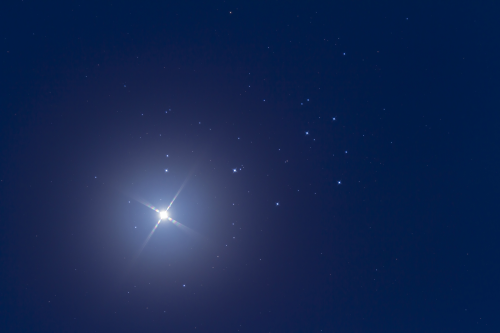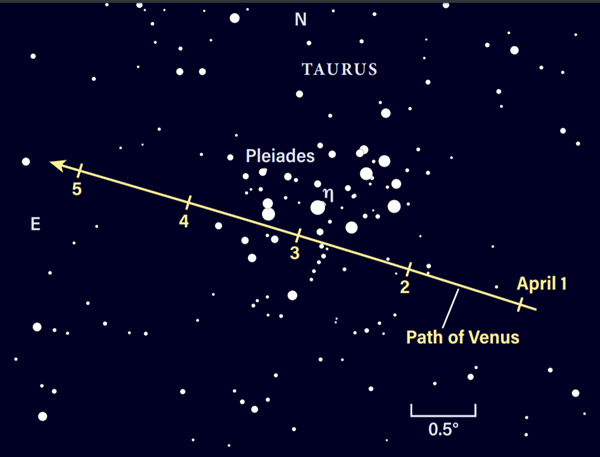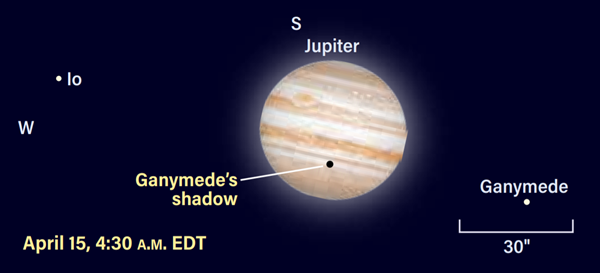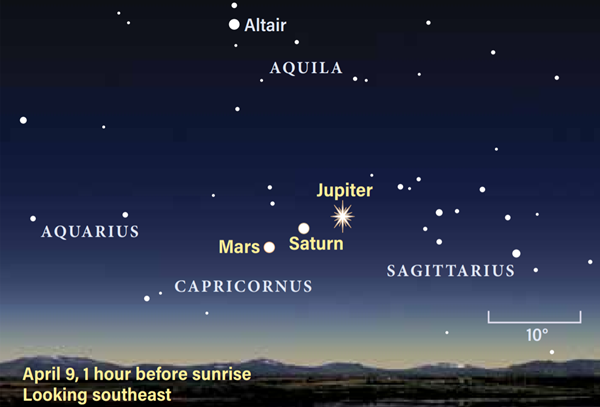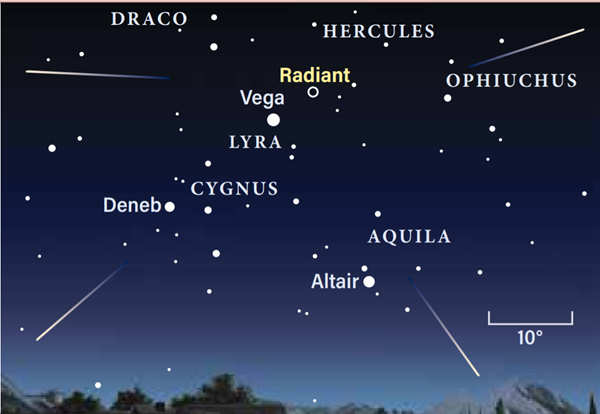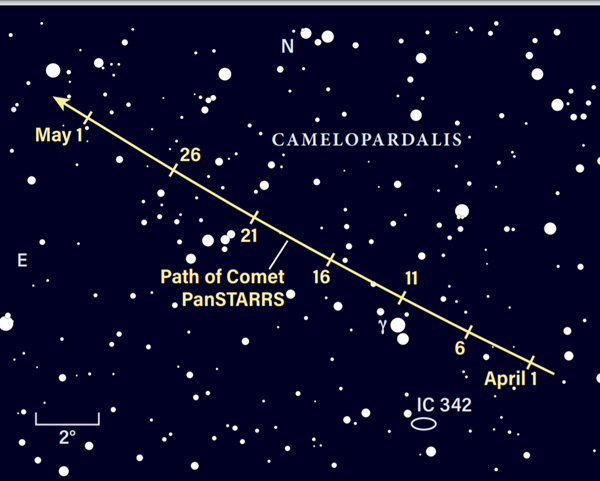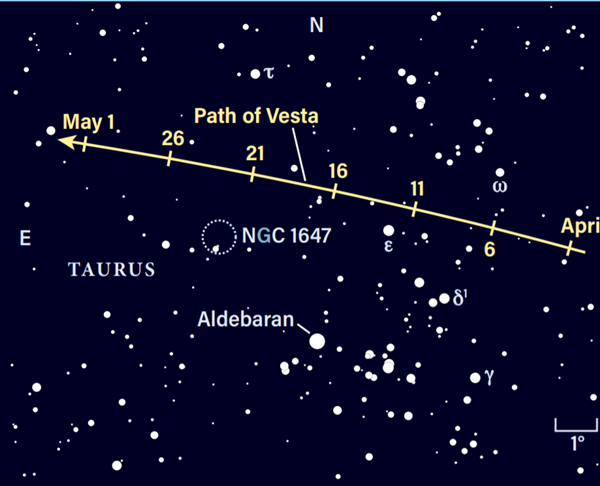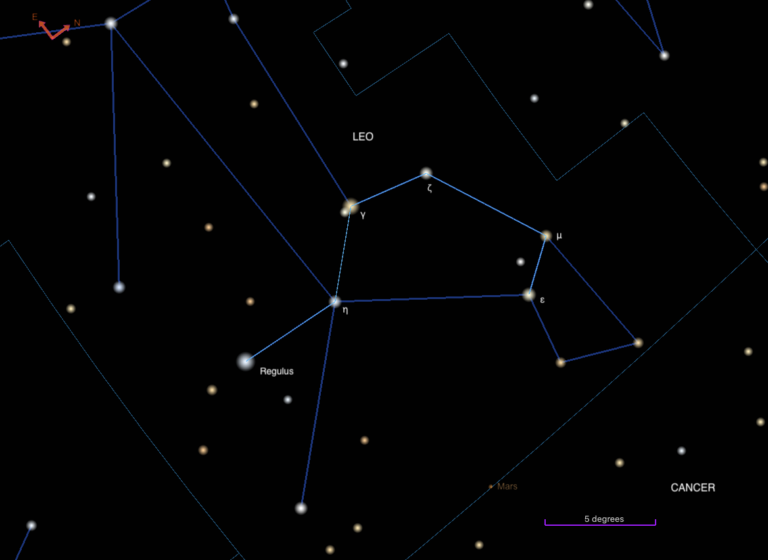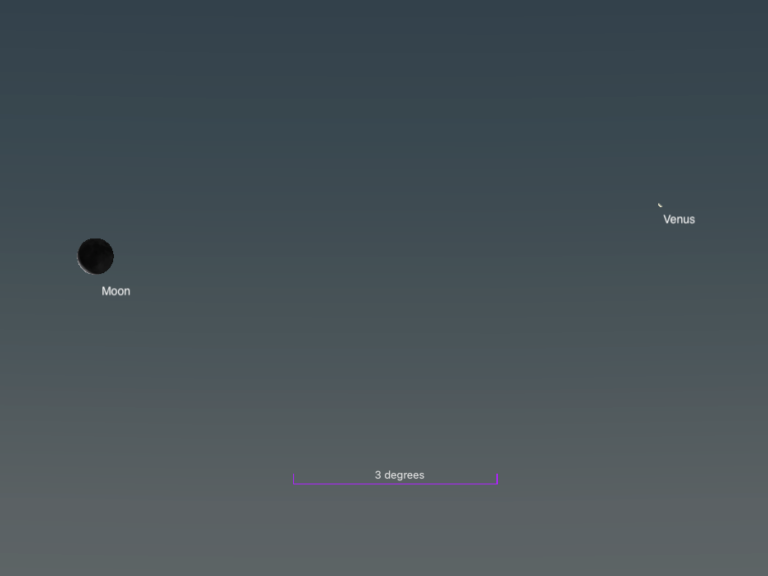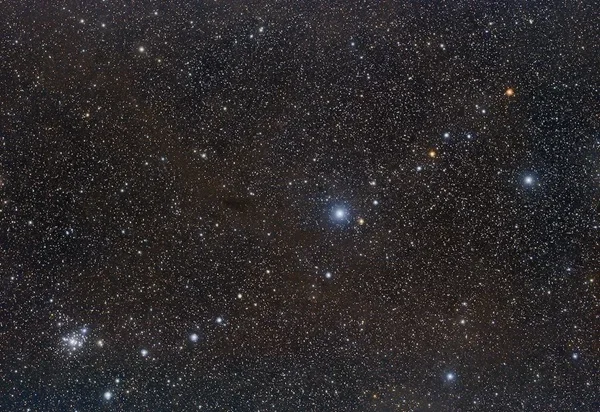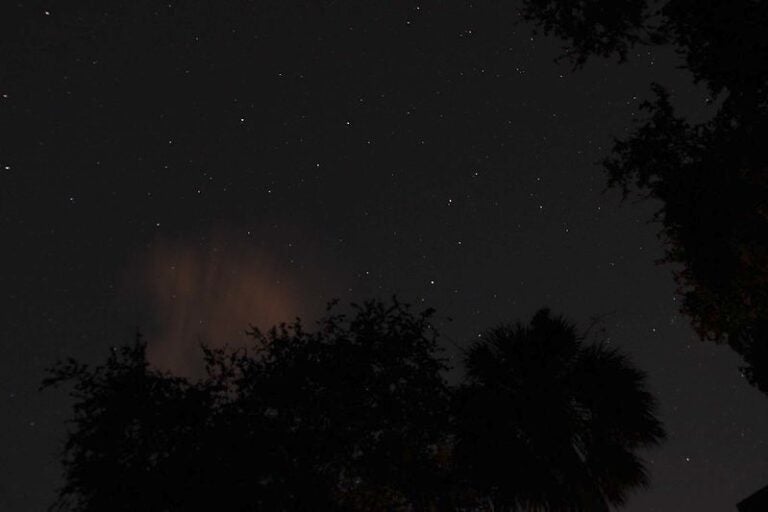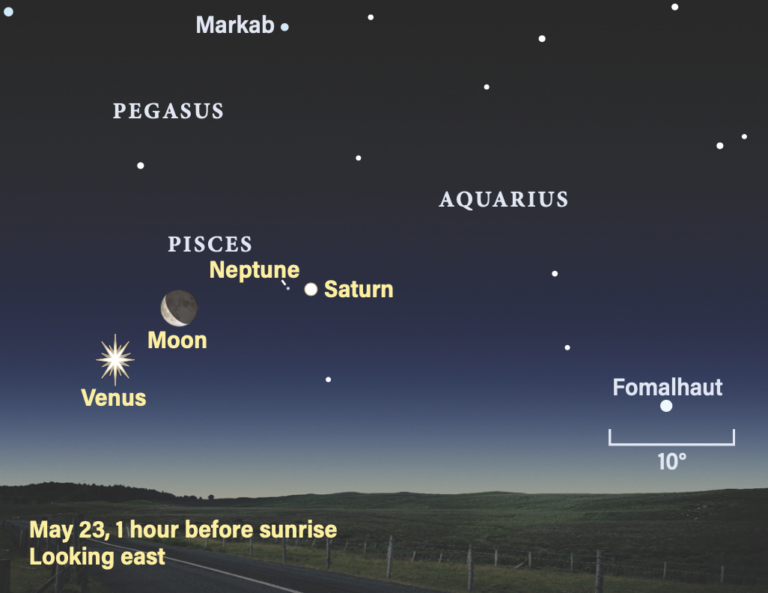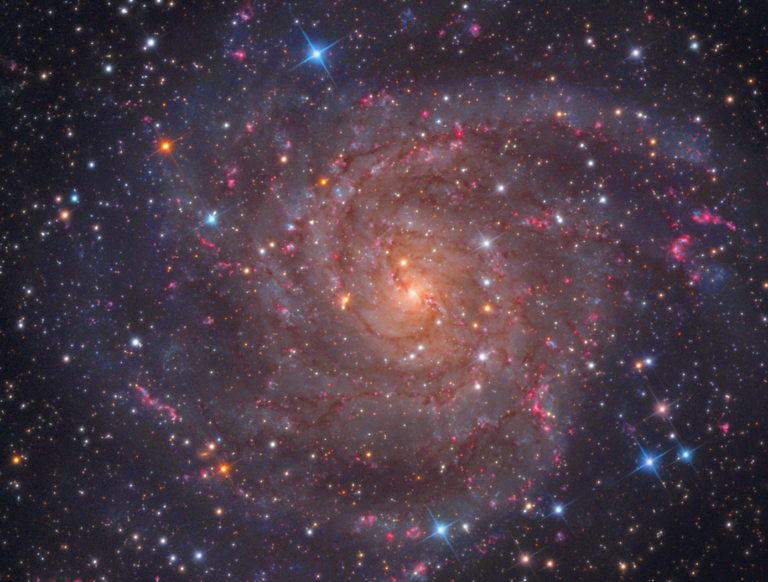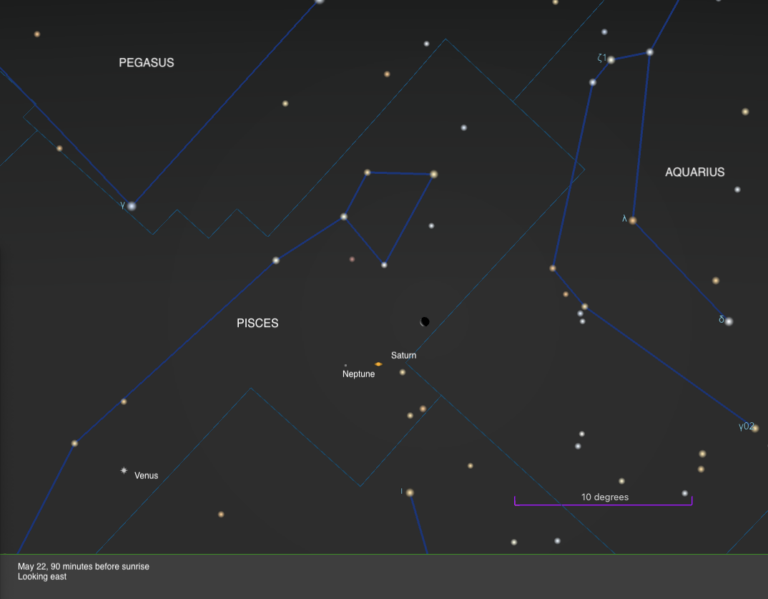As April opens, a dazzling Venus hangs in Taurus the Bull, just 1.7° below the sparkling Pleiades star cluster (M45). Over the course of a few days, the planet closes in on the sisters. Shining at magnitude –4.6, Venus overpowers the star cluster in brilliance, but the Pleiades holds its own as a star-studded region. Give yourself a treat and grab binoculars to stare at the sight for a while. It’s one you’ll never forget.
On April 3, Venus lies closest to the Pleiades, nestled just 16′ from Alcyone, the brightest star in the cluster. It’s a cosmic engagement ring, sparkling with a radiance hard to match with any terrestrial jewels.
Venus is the first object to become visible in the western sky after sunset as twilight descends. Sunset occurs near 7:30 p.m. local daylight time, and Venus stands at nearly 45° altitude due west. Watch as nightfall advances and each star in the Pleiades pops into view. By 8 p.m., many cluster stars will be visible, particularly through binoculars.
The Hyades star cluster, along with reddish Aldebaran, soon join the scene with Taurus. Then comes Orion; high above these two constellations, Gemini the Twins stands watch. An eight-day-old gibbous Moon stands 6° below Pollux on April 1. It moves farther along the ecliptic into Cancer the Crab by April 2, and into Leo April 3.
Venus continues its climb through Taurus as April progresses. By April 17 it stands 10° due north of Aldebaran. A crescent Moon returns to the scene April 25 and 26, after a full lap of Earth. It’s 3.5° north of Aldebaran on April 25, and Venus stands 10° higher. The following evening, Venus stands 7° to the right of the waxing crescent Moon in eastern Taurus. The elegant pairing is joined by the V-shaped Hyades below it, with Orion to its southeast, hugging the horizon.
There are a few asteroids in Taurus at the same time. These include Vesta, which stands 3.7° due north of Gamma (γ) Tauri (the tip of the Hyades’ V) on the 7th. At magnitude 8.4, Vesta is within easy reach of binoculars. On the 12th, it comes within 40′ of Epsilon (ε) Tau. Eleventh-magnitude Metis and 12th-magnitude Hygiea each lie within 5° of the Hyades as well.
You’ll have to wait until nearly 4 a.m. for another planet to make an appearance in early April. Jupiter rises at 3:20 a.m. on April 1, and by 2 a.m. on April 30. It’s followed soon after by Saturn and Mars, which stand 6° farther east and rise 20 minutes after Jupiter on April 1. The trio of planets makes a fine sight above the southeastern horizon in the two hours before dawn, rising with the Milky Way. On April 1, Saturn and Mars are separated by merely 1°, having passed their closest the night before.
Jupiter’s appearance through a telescope is stunning. The broad disk spans 37″ at the start of the month and grows to 41″ by the end. It’s only three months to opposition, and ardent Jupiter watchers will want to record video frames to capture the best views of the planet. Visual observers can easily catch the dark equatorial belts straddling the equator. Subtle dark belts lie to their north and south, along with smaller features such as dark and white spots that are carried along with the strong winds in Jupiter’s atmosphere. The Great Red Spot makes regular appearances as well.
Some of the most engaging events in the night sky are the repeated occultations and eclipses of Jupiter’s four giant moons: Io, Europa, Ganymede, and Callisto. Here’s a sampling of those you can catch — there are many more each month.
Ganymede, the largest of the four, casts its shadow onto the northern regions of Jupiter on April 15. The event is already underway as Jupiter rises, and ends at 5:52 a.m. EDT. You can catch Europa crossing in front of Jupiter on April 19 beginning at 5:17 a.m. EDT, and ending nearly three hours later (after sunrise on
the eastern seaboard but still under cover of darkness farther west). The following morning, April 20, Io’s shadow treks across the jovian cloud tops starting at 4:43 a.m. EDT. The moon follows at 6 a.m., and it can be tracked in darkness across the western half of the U.S.
Sometimes two events occur within minutes of each other, adding to the excitement. April 26 finds Ganymede reappearing from behind Jupiter’s southeastern limb soon after 5:20 a.m. EDT, just as Europa’s shadow begins its transit at 5:18 a.m. EDT at the northeastern limb. Ganymede takes over six minutes to fully reappear, by which time Europa’s shadow is easily visible as well.
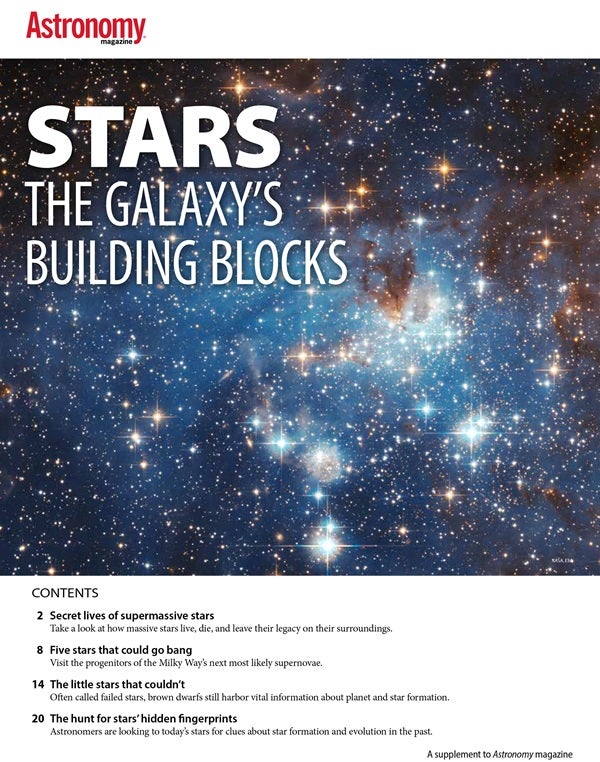
What we can learn from the life cycles of stars? Astronomy’s free downloadable eBook, Stars: The galaxy’s building blocks contains everything you need to know about how stars live, die, and change their galactic homes over time.
A telescope will easily reveal the bright ring system that dominates the view of the planet. Their widest span at midmonth is 37″ and the minor axis is 13″, while the disk spans 16″. This means the northern pole of Saturn covers the far side of the rings. Note the shadow of the planet falling on their far western side.
Saturn is accompanied by a variety of moons, the brightest of which is Titan, shining at 8th magnitude. It’s likely the only one you will see in early April, since Saturn is only about 15° high at the onset of twilight. The fainter moons may have to wait until later in the month, when the planet reaches 25° by 5 a.m. local daylight time. Smaller moons like Tethys, Dione, and Rhea shine between 10th and 11th magnitude, and orbit much closer to Saturn than Titan.
Mars is the next planet beyond Earth’s orbit and consequently moves quickly compared with the more sedentary ringed planet. Its higher velocity carries Mars quickly eastward relative to Saturn’s location; during April, the Red Planet crosses most of Capricornus, ending the month 2.7° due west of Deneb Algedi, a 3rd-magnitude star in the constellation’s northeast region.
By April 30, Mars brightens to magnitude 0.4 and is beginning to grow in apparent size, albeit slowly. Opposition is not until October, but already Mars spans more than 7″ and soon will begin to show off surface detail to smaller scopes. Right now, it’s small in a 14-inch scope.
Mercury shines at magnitude 0.0 on April 1 and you can catch it 3° high in the eastern sky 30 minutes before sunrise. On April 3, Mercury is 1.5° south of Neptune, which lies in the far distance and is too faint to see in twilight. Mercury brightens to magnitude –0.2 by April 10, but the increasing brilliance is countered by its elevation dropping slightly lower each morning at the same time before sunrise. See how far you can follow this elusive planet before it succumbs to twilight.
Uranus and Neptune are both on the far side of the solar system. You may catch a glimpse of Uranus just after sunset in early April, or sneak a peek of Neptune not long before sunrise late in the month.
RISING MOON: Walled-up perfection
Plato impresses the newcomer as much as it mesmerizes the experienced selenophile. On the evening of April 1, the large oval is a striking sight in the northern half of the Moon. Black shadows painted onto the canvas of its smooth floor retreat into the eastern wall. Over the next few hours, the rising Sun in the lunar sky shortens them even more. The mountains along the rim are not as sawtooth-shaped as their shadows imply. You can test this yourself by stepping outside near sunset and confirming that your own head isn’t as pointy as its shadow!
As an early-month bonus, look just south of the equator, where the Straight Wall casts a thin black shadow almost bisecting a larger crater.
The central peaks that formed during the birth of Plato lie below the now-solid surface. Some 3.5 billion years ago, red-hot molten lava welled up through cracks but could get no farther than the tall walls. Since then, a handful of modestly small impacts have pitted the frozen floor. With a 6-inch scope and a very steady atmosphere, patient observers can pick out the largest craterlets near the center of Plato.
Return to Plato over the next couple of evenings. A higher Sun better shows off the way the walls have slumped into the basin. You can replicate this effect at the beach by digging to different depths in moist sand and watching the sides cave in. It’s also neat to compare the texture just inside and outside the large ring — while you may not be able to resolve the tiniest features, the smooth crater floor is notably different from the dappled area beyond the elevated rim.
Have another look on the 30th to see Plato halfway across the terminator, sporting a bright rim with a jet-black interior. Closer to moonset you’ll see light creeping down the western wall as the Sun rises higher in the lunar sky.
METEOR WATCH: No Moon for April’s best display
Conditions are ideal for this year’s Lyrid meteor shower, which is active between April 14 and 30. The Moon is almost New when the peak occurs April 22 in the predawn hours. The radiant begins in Hercules and migrates one degree per day, eventually reaching Lyra; it climbs high after midnight and is almost overhead in the hour before dawn.
The expected zenithal hourly rate is 15 to 20 meteors per hour, which can be observed on the morning of peak an hour before twilight begins. Lower rates occur with the radiant lower in the sky. Meteors can appear anywhere in the sky and many are quite faint, so find a dark location and watch an area at about 45° altitude, away from Lyra. The shower has had some brief elevated rates for short periods; while none are expected this year, it’s always worth keeping count.
COMET SEARCH: A comet floats amid spirals
Come enjoy the unhurried pace of the telescopic Comet PanSTARRS (C/2017 T2). Arcing toward its close approach to the Sun in the first week of May, its 9th-magnitude glow is visible in a 4-inch scope from dark country skies. Wait until midmonth for the Moon to slide out of the way.
If you are considering a Messier marathon, put T2 in the first half of the night so it is not lost in the haze low on the northern horizon later on — and throw in the spiral galaxy IC 342 as well. Both objects are located in the less-visited constellation of Camelopardalis, but if you visualize folding the Little Dipper across Polaris, you will land smack on magnitude 4.6 Gamma (γ) Camelopardalis, the signpost labeled on the chart.
T2 is brighter than M109 (in Ursa Major) and likely more compact and, hence, well defined. Nearby IC 342 contrasts starkly because that large nearly face-on spiral has a lower surface brightness. The galaxy’s diffuse light fades as you go to higher power, but T2 will keep giving and likely reveal a nearly stellar core, with a dense shroud of dust enveloping the invisible nucleus beneath.
LOCATING ASTEROIDS: Keep trucking through Taurus
The third-largest object in the asteroid belt, 4 Vesta, passes Aldebaran, the ruddy eye of the celestial Bull, this month. That meeting makes it fairly easy to swing your scope to the right place. At 300 miles across, the potato-shaped minor planet glows at magnitude 8.5; it will require some patience and a 4-inch scope from the suburbs to pick it up. As Vesta approaches the Milky Way, the background stars become more numerous, making following it a bit like tracking a person disappearing into a crowd.
Helping us distinguish Vesta are dust lanes that block out the real profusion of stars in this section of the Perseus spiral arm of our galaxy. The surefire way of confirming which dot is Vesta and which is a star is to make a quick sketch one night, then come back on a following one to see which has moved. There really isn’t enough time in one evening to catch its shift against the background before it sets.
From April 11–13, Vesta sits a bit more than 30′ north of Epsilon (ε) Tauri. That’s the apparent diameter of the Moon. If you see a star right on the indicated path, you’ve got it! While you are in the region, check out the open star cluster NGC 1647. It contains a few dozen stars ranging from 8th to 11th magnitude. Select an eyepiece that shows a bit more than the whole Moon and wait for your eyes to dark adapt to see the fainter ones popping in.
The Moon is but a thin crescent when Vesta passes by, so it will not interfere with our observation of the asteroid this month.

